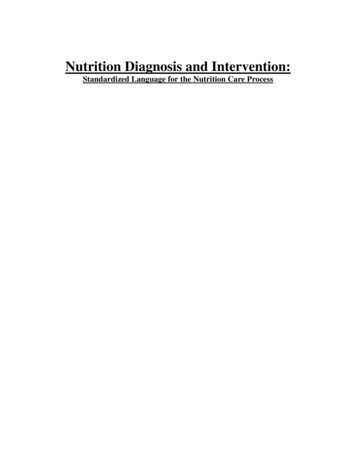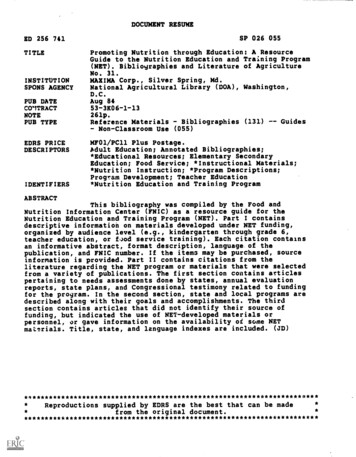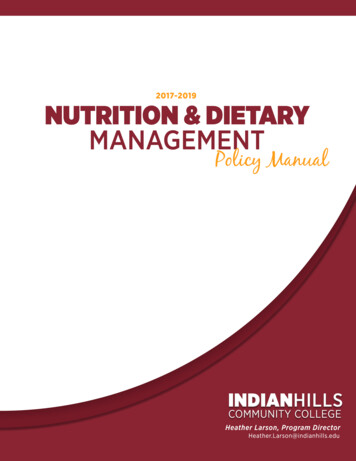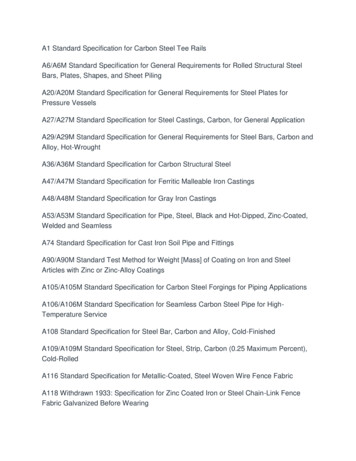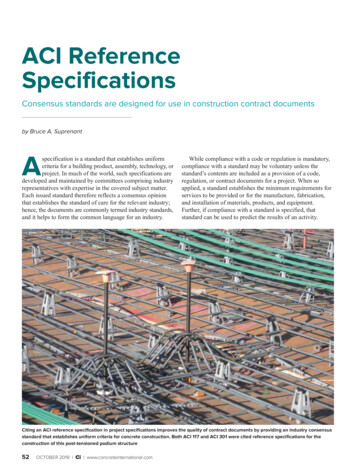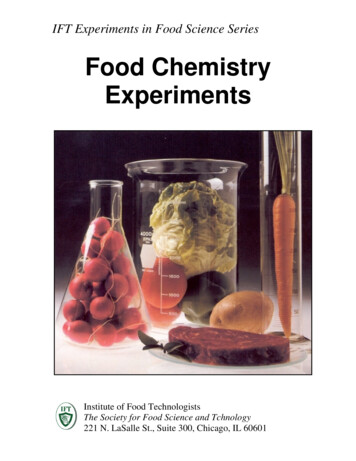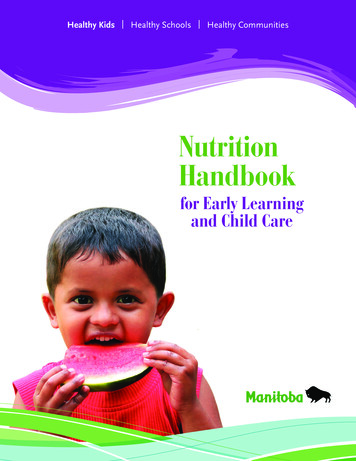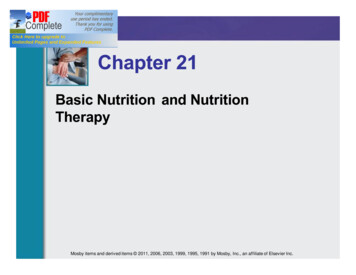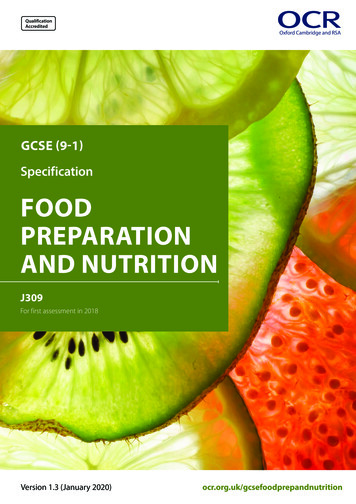
Transcription
QualificationAccreditedOxford Cambridge and RSAGCSE (9-1)SpecificationFOODPREPARATIONAND NUTRITIONJ309For first assessment in 2018Version 1.3 (January 2020)ocr.org.uk/gcsefoodprepandnutrition
DisclaimerRegistered office: The Triangle BuildingShaftesbury RoadCambridgeCB2 8EAOCR is an exempt charity.Specifications are updated over time. Whilst every effort is made to check alldocuments, there may be contradictions between published resources and thespecification, therefore please use the information on the latest specification atall times. Where changes are made to specifications these will be indicated withinthe document, there will be a new version number indicated, and a summaryof the changes. If you do notice a discrepancy between the specification and aresource please contact us at: resources.feedback@ocr.org.ukWe will inform centres about changes to specifications. We will also publishchanges on our website. The latest version of our specifications will always bethose on our website (ocr.org.uk) and these may differ from printed versions. 2021 OCR. All rights reserved.CopyrightOCR retains the copyright on all its publications, including the specifications.However, registered centres for OCR are permitted to copy material from thisspecification booklet for their own internal use.Oxford Cambridge and RSA is a Company Limited by Guarantee. Registered inEngland. Registered company number 3484466.
ContentsSupport and Guidance Assessment Preparation and Analysis Service 12345iiiiiWhy choose an OCR GCSE (9–1) in Food Preparation and Nutrition? 11a.1b.1c.1d.Why choose an OCR qualification? Why choose an OCR GCSE (9–1) in Food Preparation and Nutrition? What are the key features of this specification? How do I find out more information? 1233The specification overview 42a.2b.2b.2b.2b.2b.2c.2d.OCR’s GCSE (9–1) in Food Preparation and Nutrition (J309) Content of the OCR GCSE (9–1) in Food Preparation and Nutrition (J309) Content of Section A: Nutrition Content of Section B: Food (food provenance and food choice) Content of Section C: Cooking and food preparation Content of Section D: Skills requirements (preparation and cooking techniques) Content of non-examined assessment (NEA) Prior knowledge, learning and progression 456911131515Assessment of the OCR GCSE (9–1) in Food Preparation and Nutrition 163a.3b.3c.3d.3e.3f.3g.3h.3i.Forms of assessment Assessment objectives (AO) AO weightings in the OCR GCSE (9–1) Food Preparation and Nutrition Assessment availability Retaking the qualification Assessment of extended response Non-examined assessment (NEA) Synoptic assessment Calculating qualification results 161919192020203131Admin: what you need to know 324a.4b.4c.4d.4e.4f.4g.Pre-assessment Special consideration External assessment arrangements Admin of non-examined assessment Results and certificates Post-results services Malpractice 32343434373737Appendices 385a.5b.5c.5d.Grade descriptors Overlap with other qualifications Accessibility Accepted file formats 38393939Summary of updates 40 OCR 2021GCSE (9–1) in Food Preparation and Nutritioni
Support and GuidanceIntroducing a new specification brings challenges forimplementation and teaching, but it also opens up newopportunities. Our aim is to help you at every stage. Weare working hard with teachers and other experts tobring you a package of practical support, resources andtraining.throughout the lifetime of the specification, theyinclude:Subject AdvisorsWe also work with a number of leading publishers whopublish textbooks and resources for our specifications.For more information on our publishing partners andtheir resources blishingpartnerOCR Subject Advisors provide information and supportto centres including specification and non-examassessment advice, updates on resource developmentsand a range of training opportunities.Our Subject Advisors work with subject communitiesthrough a range of networks to ensure the sharing ofideas and expertise supporting teachers and studentsalike. They work with developers to help produce ourspecifications and the resources needed to support thesequalifications during their development.You can contact our Food and Nutrition Subject Advisorsfor specialist advice, guidance and support:01223 553998Food@OCR.org.uk@OCR FoodTeaching and learning resourcesOur resources are designed to provide you with a rangeof teaching activities and suggestions that enable you toselect the best activity, approach or context to supportyour teaching style and your particular students. Theresources are a body of knowledge that will growii Delivery GuidesTransition GuidesTopic Exploration PacksLesson Elements.Professional developmentOur improved Professional DevelopmentProgramme fulfils a range of needs throughcourse selection, preparation for teaching, deliveryand assessment. Whether you want to come toface-to-face events, look at our new digital trainingor search for training materials, you can find whatyou’re looking for all in one place at the CPD Hub:cpdhub.ocr.org.ukAn introduction to new specificationsWe run training events throughout the academic yearthat are designed to help prepare you for first teachingand support every stage of your delivery of the newqualifications.To receive the latest information about the trainingwe offer on GCSE and A Level, please register for emailupdates at: ocr.org.uk/updates OCR 2021GCSE (9–1) in Food Preparation and Nutrition
Assessment Preparation and Analysis ServiceAlong with subject-specific resources and tools, you’llalso have access to a selection of generic resources thatfocus on skills development, professional guidance forteachers and results data analysis.Subject Advisor SupportOur Subject Advisors provide you with access to specifications, high-quality teaching resources andassessment materials.Active ResultsOur free online results analysis service helps you review the performance of individual students or yourwhole cohort. For more details, please refer to ocr.org.uk/activeresultsSkills GuidesThese guides cover topics that could be relevant to a range of qualifications, for examplecommunication, legislation and research. Download the guides at ocr.org.uk/skillsguides OCR 2021GCSE (9–1) in Food Preparation and Nutritioniii
iv OCR 2021GCSE (9–1) in Food Preparation and Nutrition
1Why choose an OCR GCSE (9–1) in FoodPreparation and Nutrition?1a. Why choose an OCR qualification?Choose OCR and you’ve got the reassurance thatyou’re working with one of the UK’s leadingexam boards. Our new OCR GCSE (9–1) in FoodPreparation and Nutrition course has beendeveloped in consultation with teachers, employersand Higher Education to provide learners with aqualification that’s relevant to them and meetstheir needs.We’re part of the Cambridge Assessment Group,Europe’s largest assessment agency and adepartment of the University of Cambridge.Cambridge Assessment plays a leading role indeveloping and delivering assessments throughoutthe world, operating in over 150 countries.We work with a range of education providers,including schools, colleges, workplaces and otherinstitutions in both the public and private sectors.Over 13,000 centres choose our A Levels, GCSEs andvocational qualifications including CambridgeNationals and Cambridge Technicals.Our specificationsWe believe in developing specifications that help youbring the subject to life and inspire your learners toachieve more.We’ve created teacher-friendly specifications basedon extensive research and engagement with theteaching community. They’re designed to bestraightforward and accessible so that you can tailorthe delivery of the course to suit your needs. We aim OCR 2021GCSE (9–1) in Food Preparation and Nutrition1to encourage students to become responsible fortheir own learning, confident in discussing ideas,innovative and engaged.We provide a range of support services designed tohelp you at every stage, from preparation through tothe delivery of our specifications. This includes: A wide range of high-quality creative resourcesincluding: Delivery Guides Transition Guides Topic Exploration Packs Lesson Elements . . . and much more. Access to Subject Advisors to support youthrough the transition and throughout thelifetimes of the specifications. CPD/Training for teachers to introduce thequalifications and prepare you for firstteaching. Active Results – our free results analysis serviceto help you review the performance ofindividual learners or whole schools.All GCSE (9–1) qualifications offered by OCR areaccredited by Ofqual, the Regulator for qualificationsoffered in England. The accreditation number forOCR’s GCSE (9–1) in Food Preparation and Nutrition isQN 601/8379/2.1
1b. Why choose an OCR GCSE (9–1) in Food Preparation and Nutrition?1OCR’s GCSE (9–1) in Food Preparation and Nutritionqualification aims to equip learners with theknowledge, understanding and skills required to cookand apply the principles of food science, nutrition andhealthy eating. The OCR qualification will encouragelearners to cook and make informed decisions abouta wide range of further learning, opportunities andcareer pathways as well as develop life skills thatenable learners to feed themselves and othersaffordably, now and in later life.OCR’s GCSE (9–1) in Food Preparation and Nutrition isa new, exciting, up-to-date qualification that isrelevant to the world of food today.This qualification aims to bring about real sustainablechange, providing learners with the expertise andskills to feed themselves and others better.The heart of our qualification is the development ofstrong practical cookery skills and techniques as wellas a good understanding of nutrition. We believe thatlearners who learn to cook well are more likely tomake better food choices and understand healthyeating.OCR learners will discover the essentials of foodscience, nutrition and how to cook. In addition tothis, learners will understand the huge challengesthat we face globally to supply the world withnutritious and safe food.OCR sees this qualification as another step towardscreating a healthier society and improving thenation’s cooking skills as well as setting some learnerson the path to careers in the food and hospitalityindustries.Our qualification builds upon the best elements ofour existing and current qualifications and adds newareas of interest.Aims and learning outcomesThe OCR GCSE (9–1) in Food Preparation andNutrition will encourage learners to: 2demonstrate effective and safe cooking skills byplanning, preparing and cooking using a varietyof food commodities, cooking techniques andequipmentdevelop knowledge and understanding of thefunctional properties and chemical processesas well as the nutritional content of food anddrinksunderstand the relationship between diet,nutrition and health, including the physiologicaland psychological effects of poor diet andhealth understand the economic, environmental,ethical and socio-cultural influences on foodavailability, production processes and diet andhealth choices demonstrate knowledge and understanding offunctional and nutritional properties, sensoryqualities and microbiological food safetyconsiderations when preparing, processing,storing, cooking and serving food understand and explore a range of ingredientsand processes from different culinary traditions(traditional British and international), to inspirenew ideas or modify existing recipes. OCR 2021GCSE (9–1) in Food Preparation and Nutrition
1c.What are the key features of this specification? Developing an interest in the creative aspectand enjoyment of food. Developing confidence in using the high levelskills necessary in food preparation andcooking. Making connections between theory andpractice so that learners are able to apply theirunderstanding of food and nutrition and foodscience to practical cooking. Developing an informed approach that will helplearners to evaluate choices and decisionsabout their own diet and health. Support from industry experts and employers. Using a simple assessment model with clearmarking criteria.1d. How do I find out more information?If you are already using OCR specifications you cancontact us at: www.ocr.org.ukWant to find out more?If you are not already a registered OCR centre thenyou can find out more information on the benefits ofbecoming one at: www.ocr.org.ukEmail: Food@ocr.org.ukIf you are not yet an approved centre and would liketo become one go to: www.ocr.org.ukFax: 01223 552627 or 01223 553998Contact a Subject Advisor:Tel: 01223 553998Visit our Online Support Centre at support.ocr.org.ukCheck what CPD events are available:www.cpdhub.ocr.org.ukFollow us on Twitter: @ocr food OCR 2021GCSE (9–1) in Food Preparation and Nutrition31
2The specification overview2a. OCR’s GCSE (9–1) in Food Preparation and Nutrition (J309)There are two submission options for the non-examined assessment (NEA), postal submission or electronicupload via the OCR Repository.Repository option: Learners must take (01), (02) and (04).Postal option: Learners must take (01), (03) and (05).2Content OverviewThis content should be coveredthroughout all threecomponents.Section ANutritionSection BFood: food provenance andfood choiceSection CCooking and food preparationSection DSkills requirements: preparationand cooking techniquesAssessment OverviewFood Preparation andNutrition (01)*100 marks**1 hour 30 minuteswritten examination paperFood InvestigationTask (02 or 03)*45 marksNon-examinedassessment (NEA)Food PreparationTask (04 or 05)*105 marksNon-examinedassessment (NEA)50%of totalGCSE15%of totalGCSE35%of totalGCSE*Indicates inclusion of synoptic assessment.** Examination is weighted up to 150 marks to equal the total marks combined for the two tasks.4 OCR 2021GCSE (9–1) in Food Preparation and Nutrition
OCR 2021GCSE (9–1) in Food Preparation and Nutrition2b. Content of the OCR GCSE (9–1) in Food Preparation and Nutrition (J309)The range of foods studied within the content of the OCR GCSE (9–1) FoodPreparation and Nutrition will be based on the government’s current adviceon a healthy balanced diet.There are four sections covering the content – Section A: Nutrition, Section B:Food (food provenance and food choice), Section C: Cooking and foodThe range of foods and ingredients to be studied in ALLsectionsThe major commodity groupspreparation and Section D: Skill requirements (preparation and cookingtechniques). Content from all these sections may be tested in the examination.The following table explains the range of foods and ingredients that will need tobe studied and can be assessed in either the exam or non-examined assessment(NEA). Any content stating food relates to food and drink.Learners should be ableto demonstrate and apply theirknowledge and understanding of:Points to coverBread, rice, potatoes, pasta and otherstarchy foodsPBread, rice, potatoes, pasta, flour and cereals(including wheat, oats, maize, barley, rye)Fruit and vegetablesPFresh, frozen, dried, canned and juiced fruitand vegetablesMilk and dairy foodsPMilk, cream, cheese and yoghurtMeat, fish, eggs, beans and other non-dairysources of proteinPMeat, fish, eggs, beans, nuts, seeds andalternative protein foods (Quorn , soya:textured vegetable protein TVP , tofu)Foods and drinks high in fat and/or sugar.PButter, margarine, spreads, plant oils, sugarand syrup.52
262b. Content of Section A: NutritionTopic12 OCR 2021GCSE (9–1) in Food Preparation and Nutrition3The relationship betweendiet and healthNutritional and dietaryneeds of different groups ofpeopleNutritional needs whenselecting recipes fordifferent groups of peopleLearners should be able to demonstrate andapply their knowledge and understanding of:Points to coverA balanced diet to provide the correct combinationof food and nutrients for good healthPPThe importance of a healthy dietHow to use the major commodity groups to make a balancedfood choiceThe government’s guidelines for a healthy diet andthe inclusion of new regulations as they are issuedPThe application of the eight tips for healthy eatingMajor diet-related health issuesPDiet-related diseases and conditions: obesity (weight loss andgain), cardiovascular, coronary heart disease (CHD), diabetes,diverticulitis, bone health (osteoporosis), dental health, anaemiaand high blood pressureDietary needs for different stages of lifePBalanced combinations of food, nutrients and correct portionsizes for babies, toddlers, pre-school children, school-agedchildren, adolescents, adults, older people, pregnant andlactating womenFood allergies and intolerancesPPFoods that may cause an allergic reactionFood intolerance: lactose and gluten (coeliacs)The dietary reference values (DRVs)Macronutrients and micronutrientsCalculation of nutritional valuesPRecommended daily amounts of macro and micro nutrientsand energyPlan recipes, meals and diets based on nutritional analysisModifying recipes and meals to follow currentdietary guidelinesPPAltering or substituting ingredients, changing the method ofcooking or process and changing the portion size
OCR 2021GCSE (9–1) in Food Preparation and NutritionTopic4Energy balanceLearners should be able to demonstrate andapply their knowledge and understanding of:Points to coverThe relationship between food intake and physicalactivity and how to maintain a healthy body weightthroughout lifePBasal metabolic rate (BMR) and physical activity level (PAL) andtheir importance in determining energy requirementsHow to calculate energy values and the mainsources of energy in the dietPPPRecommended percentage of daily energy intakeSources of energy: protein, fat, carbohydrate and alcoholUnits (kcal and kJ) for measuring energyThe main factors that influence an individual’senergy requirementsPGender, life stage, pregnancy/lactation, size/body weight,genetics, occupation and lifestyleDeficiency and s)Types and functionsPTypes and structure: High biological value (HBV) and lowbiological value (LBV)Functions and deficiencySourcesPAnimal and vegetableTypes and functionsPPTypes and structure: fats and oils (saturated, unsaturated andpolyunsaturated)Functions and deficiencySourcesPAnimal and vegetable: visible and invisibleTypes and functionsPPSugar: monosaccharides, disaccharides, starch: complexcarbohydrates and fibreFunctions and deficiencySourcesPSugar, starch and fibreTypes and functionsPPPFat soluble vitamins: A (retinol and carotene), D, E, KWater soluble vitamins: B1 (thiamine), B2 (riboflavin), B3 (niacin),B9 (Folate/Folic acid), B12 (cobalamin), C (ascorbic acid)Functions and deficiencyPFood sources of vitaminsSourcesP72
al content of themain commodity groupsLearners should be able to demonstrate andapply their knowledge and understanding of:Points to coverTypes and functionsPPCalcium, iron, sodium, fluoride, iodine, phosphorusFunctions and deficiencySourcesPFoods that supply mineralsImportance of waterPPFunctions and deficiencyRecommended guidelines for daily intake of waterSourcesPSources and foods that give us waterBread, rice, potatoes, pasta and other starchy foodsFruit and vegetablesMilk and dairy foodsMeat, fish, eggs, beans and other non-dairysources of proteinFoods and drinks high in fat and/or sugarPNutritional content of each commodity group OCR 2021GCSE (9–1) in Food Preparation and Nutrition
OCR 2021GCSE (9–1) in Food Preparation and Nutrition2b. Content of Section B: Food (food provenance and food choice)Topic1FOOD PROVENANCE:Food source and supplyLearners should be able todemonstrate and apply theirknowledge and understanding of:Food sources and how they are:PPPAdvantages and disadvantages of locally produced and seasonal foodsWhere and how they are grown: organic and non-organic farmingClassification of fruits and vegetablesPPWhere and how they are reared: intensive farming methods, free-rangeproducts, rearing of the animalsClassification of meat, poultry and gamec) caught: fishPPWhere and how they are caught: sustainable fish supplyClassification of fishPrimary stages of food processingPPHow wheat is milled and processed to produce flourHeat treatment of milkSecondary stages of food processingand productionPPPThe processes that raw food undergoes to transform it into a food productHow milk is processed to produce butter, cream, yoghurt and cheeseHow flour is used to produce bread and pastaFood processing and preservingmethods: industrial and domesticPHigh temperatures: pasteurisation, sterilisation (ultra heat treated (UHT) andcanning)Cold temperatures: chilling, freezing, cook-freeze/blast chilling and acceleratedfreeze-drying (AFD)Drying and smokingUsing acids, salt and sugarControlled atmosphere packaging (CAP)/modified atmosphere packaging (MAP)and vacuum packinga) grown: cereals, sugars, fruits andvegetablesb) reared: meat and poultry2Food processing andproductionPoints to coverPPPP92
210Topic3Food securityLearners should be able todemonstrate and apply theirknowledge and understanding of:The impact of food and food securityon society, local and global marketsand the environmentPPPPPPThe availability of food, the access to food, the individual’s ability to utilise foodMoral issues: how Fairtrade affects food producers and workersEthical issues: relating to the development of genetically modified (GM) foodEnvironmental issues: food wasteCarbon footprint and the transportation of materials and goodsSustainability of resourcesFortificationPThe advantages and disadvantages of fortificationUse of additivesPPreservatives, colourings, flavourings and sweeteners, emulsifiers and stabilisersand thickeners, antioxidantsNew and emerging foodsPProbiotics and prebioticsMoral/ethical and environmentalissues involved in food production4Technologicaldevelopments tosupport better healthand food productionPoints to cover OCR 2021GCSE (9–1) in Food Preparation and Nutrition5Development ofculinary traditions(learners must studyBritish cuisine and aminimum of TWOinternational cuisines)Features and characteristics ofindividual cuisinesPPPPRecognise traditional ingredientsUnderstand religious or cultural factors affecting the cuisineUnderstand traditional cooking methods, presentation and eating patternsRecognise how the traditional recipes have been adapted to suit today’s society6Factors influencing foodchoicePersonal, social and economic factors,medical reasonsPFood choice can be affected by cost, enjoyment, preference, seasonality,availability, time of day, activity, celebration or occasionConsumer information, food labelling, marketingPReligious and cultural beliefsPFood choice can be affected by related beliefs of major religions: Buddhism,Hinduism, Islam, Judaism, Rastafarianism and SikhismEthical and moral beliefsPVegetarians (lacto-ovo, lacto, ovo and vegans), animal welfare, local produce,organic food
OCR 2021GCSE (9–1) in Food Preparation and Nutrition2b. Content of Section C: Cooking and food preparationTopic12Food ScienceSensory propertiesLearners should be able todemonstrate and apply theirknowledge and understanding of:Points to coverThe reasons why food is cookedPPMaking food safe to eatMaking food more digestible/palatableHeat transfer through cookingmethodsPConduction, convection and radiationHow preparation and cookingmethods/processing affect the nutritional value improve the sensory propertiesPPEnrichment/loss, increase/reduce calorific value, vitamin lossesTexture, flavour, appearance, aromaWorking characteristics and thefunctional and chemical properties ofingredient groupsPPPPPCarbohydrates: gelatinisation, dextrinisation, caramelisationFats/oils: shortening, aeration, plasticity, emulsificationProtein: coagulation, foam formation, gluten formation, acid denatureFruit and vegetables: enzymic browning/oxidisationRaising agents: yeast, chemical agents, air and steamThe senses (organoleptic properties)PChanges that happen when food is cooked: texture, appearance, colourtaste, sound and aromaSensory systemsPThe importance of the senses of sight, taste, touch, smell and hearing andhow they work when making food choicesThe five basic tastes recognised by receptors (sweetness, sourness,bitterness, saltiness and umami)PPreferential and sensory testing panelsPPHow to set up a testing panelStyles and forms of rating, ranking and profiling systems with the use ofappropriate descriptive terminology112
212Topic3Food safetyLearners should be able todemonstrate and apply theirknowledge and understanding of:Points to coverConditions and control for bacterialgrowthPThe role of time, temperature, moisture and food availabilityGrowth conditions and control formould growth and yeast productionPThe role of time, temperature, moisture and food availabilitySigns of food spoilagePNatural decay, enzyme action and yeast productionHelpful properties of micro-organismsin food productionPTypes of micro-organisms and key pointsBuying foodPPPLabelling and date marksVisual checksReputable supplierStoring foodPTypes of storage and how to store foods correctlyPreparing foodPPreventing cross contamination and food poisoning: direct and indirectmethodsCooking and serving foodPHigh-risk foods, critical temperatures OCR 2021GCSE (9–1) in Food Preparation and Nutrition
OCR 2021GCSE (9–1) in Food Preparation and Nutrition2b. Content of Section D: Skills requirements (preparation and cooking techniques)This section shows skills requirements: preparation and cooking techniques that can be applied and combined to achieve specific outcomes and how they relate to theknowledge and understanding from Sections A, B and C.Throughout this section learners should be able to: demonstrate accurate weighing and measurement of liquids and solids grease/oil, line, flour flan rings or tins evenly select and adjust the cooking process and length of time to suit the ingredient test for readiness (use of temperature probe, skewer/knife, finger or ‘poke’ test, ‘bite’, visual colour or sound test) use specialist equipment where appropriate (different knives, food processor, mixer, blender, microwave, potato ricer and pasta machine) understand the functions of ingredients in basic recipes.No.1Skill groupKnife skillsTechniques 2Preparation andtechniques 3Cooking methods Meat, fish or alternatives: fillet a chicken breast, portion a chicken, remove fat and rinds, fillet fish, slice raw and cookedmeat and fish or alternatives (such as tofu and halloumi) evenly and accuratelyFruits and vegetables: bridge hold, claw grip, peel, slice, dice and cut into evenly sized pieces (i.e. batons, julienne)Tenderise and marinate (when preparing vegetables, meat, fish, and alternatives): acids to denature protein, marinate toadd flavour and moistureMeat, fish or alternatives: roll, wrap, skewer, mix, coat, layer meat, fish and alternatives and shape and bind wet mixtures(such as falafels, meat balls, fish cakes) while demonstrating the technical skill of preventing cross-contamination andhandling high-risk foods correctlyFruits and vegetables: mash, shred, scissor-snip, scoop, crush, grate, peel, segment, de-skin, deseed, blanch, shape, pipe,blend, juice and prepare garnishes whilst demonstrating the technical skills of controlling enzymic browning and spoilageand preventing food poisoning (wash and dry, where appropriate)Water-based methods using the hob: steaming, boiling and simmering, blanching and poachingDry heat and fat based methods using the hob: dry-frying, pan (shallow frying), stir-fryingUsing the grill: char, grill or toastUsing the oven: baking, roasting, casseroles and/or tagines, braising132
214No.4Skill groupSaucesTechniques Make a blended white sauce (starch gelatinisation), such as a roux, and an all-in-one blended sauce, infused sauce, veloute,bechamel, to demonstrate understanding of how liquid:starch ratios affect the viscosity and how conduction andconvection work to cook the sauce and the need for agitationMake a reduction sauce such as pasta sauce, curry sauce, gravy, meat sauce (including meat alternatives such as mycoprotein and textured vegetable protein) to demonstrate how evaporation concentrates flavour and changes the viscosity ofthe sauceMake an emulsion sauce such as a salad dressing, mayonnaise, hollandaise to demonstrate the technical skill of how tomake a stabilised emulsion OCR 2021GCSE (9–1) in Food Preparation and Nutrition5Set a mixture Removal of heat (gelation): use starch to set a mixture on chilling for layered desserts such as custard or cheesecakeHeating (coagulation): use protein to set a mixture on heating such as denatured protein in eggs for quiche, choux pastry6Raising agents Use egg (colloid foam) as a raising agent – create a gas-in-air foam – whisking egg whites, whisked sponge,Use chemical raising agents – self-raising flour, baking powderUse steam in a mixture (choux pastry, batter)7Dough Use the technical skills of shortening, gluten formation, fermentation (proving) for bread, pastry, pastaRoll out pastry, use a pasta machine, create layers (palmiers), proving/restingGlazing and finishing such as pipe choux pastry, bread rolls, pasta, flat breads, pinwheels, pizza, calzone8Judge and manipulatesensory properties Taste and season during the cooking process, change the taste and aroma through the use of infusions, herbs and spices,paste, jus, reductionChange texture and flavour, use browning (dextrinisation) and glazing, add crust, crisp and crumbsPresentation and food styling – use garnishes and decorative techniques to improve the aesthetic qualities, demonstrateportioning and presenting
2c.Content of non-examined assessment (NEA)These are the components of the qualification that will be assessed by the teacher.Food Investigation Task (02, 03)2This task is worth 15% of the qualification andassesses th
make better food choices and understand healthy eating. OCR learners will discover the essentials of food science, nutrition and how to cook. In addition to this, learners will understand the huge challenges that we face globally to supply the world with nutritious and safe food. OCR sees this qualification as another step towards

